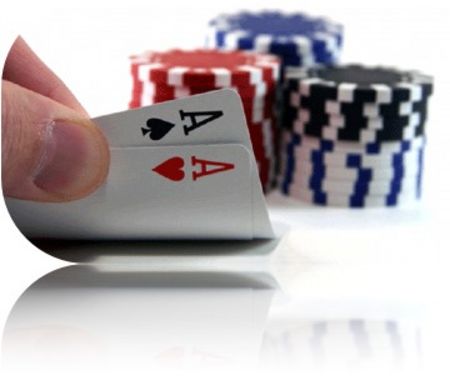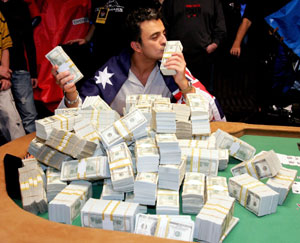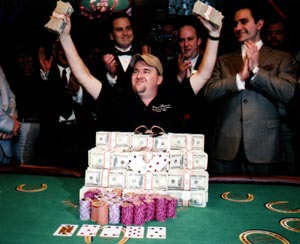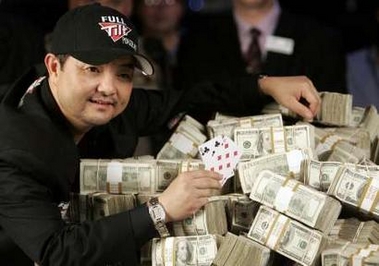Three of a Kind

Three of a kind flops like JJJ occur only once every 425 hands. If you are lucky
enough to hold four of a kind, you should probably slowplay, although you could
play aggressively if you believe an opponent will give you good action with a high
pocket pair. Pocket pairs are very strong hands since four of a kind is an unlikely
holding from one of your opponents. Obviously the higher your pair the better, and
you must protect your medium and small pairs from overcards. In a heads-up
situation, another playable hand would be ace high, unless there was a preflop
raise by an opponent with a possible pocket pair.
High Pair
A flop with a high pair such as QQT or JJ6 is always dangerous since many players
play high cards. You need a full house or trips to feel comfortable with your hand. In
most cases, when the flop is bet and called by a second player, you are usually
beat if you do not hold trips or better. High pocket pairs are decent holdings if you
feel that the risk of an opponent holding trips is low, This is mainly dependent on
the number of players in the hand Against one opponent, a strong pocket pair
usually is a good hand, but with four or five players seeing the flop you must play
cautiously.
Flush and straight draws drop significantly in value with a pair on the flop. It's
possible that you are drawing dead if an opponent already has a full house. For
example, if you hold KJ with a QTT flop, you are drawing dead if an opponent holds
QQ, TT, or QT. Also note that your straight draw only has four outs if an opponent
holds AT or T9. Another problem with these flops is that even when you hit your
draw on the turn, an opponent with trips has ten outs to beat you on the river. For
these reasons, be careful playing flush and straight draws on the flop when there is
a high pair. The exceptions are when you are relatively confident that an opponent
doesn't hold trips or you are getting exceptionally good pot odds.
Low Pair
Compare QTT with a flop of Q55. Most good players will not play a hand with a 5
unless they were able to see the flop cheaply from late position or the blinds. If the
pot was raised preflop and there are not many opponents, you usually can worry
less about a low pair on the flop. Conversely, if the blinds are playing or there are
many players in the pot, proceed with caution as indicated in the high pair section.
Two-Suited

One of the first things you should always look for on the flop is whether or not it is
two-suited. You can always play flush draws when there is no pair and there are at
least two callers. In heads-tip situations, your draw is also almost always worth
playing unless the pot is small and you are sure your opponent has a pair higher
than the two cards in your hand.
If you don't have a flush draw, you must worry about other players having a draw. If
there are several players who call a bet with a two-suited flop, it is almost
guaranteed that at least one opponent has a flush draw. All hands go down in value
against two-suited flops. This means that borderline hands with a rainbow flop
should often be folded with a two-suited flop. Your stronger holdings such as top
pair are usually still good hands, but you may need to fold if a third suited card
comes on the turn or river. Overcards drop significantly in value with a two-suited
flop.
If you hold an ace or king of the same suit as the two-suited flop, you have a
backdoor flush draw, which adds a little extra to your hand. In big pots against
several players, the addition of a backdoor flush draw to an otherwise mediocre
hand may make your hand playable. For example, middle pair with an overcard
might become playable if you have a backdoor flush draw also and the pot is very
large.
Three-Suited
Three-suited flops occur about 5% of the time. If you flop the nut flush, you can
consider slowplaying the hand. Generally you should play flushes that aren't the
nuts strongly, since you need to protect your hand and can expect to get good
action from players on draws.
If you have a flush draw with one of the top two available suited cards, you can
always play the hand to the river. Usually fold draws to the third or fourth highest
suited card unless your hand has other possibilities, If you have a set, you can play
it strongly if you feel nobody has the flush; otherwise, you still can play to the river
drawing to a full house. All other hands should be played with caution. Straights are
still playable in most cases.
Straight draws are practically worthless unless your hand has other possibilities and
you feel nobody has a flush. Middle or bottom pair should be thrown away in almost
all circumstances. Top pair and overpairs should sometimes be played
conservatively until the turn card, especially against several opponents. Overcards
should almost never be played unless you have a good flush draw with your hand.
Two-Connected

An open-ended straight draw is a strong hand with rainbow flops. These draws
become even stronger if you have overcards also. For example, Q
♦ J
♥ is a very
strong hand with a flop of T
♥ 9 ♠ 5 ♣. The only time you might consider folding an
open-ended straight draw with a rainbow unpaired flop is when you are heads up,
the pot is small, and you are sure your opponents have a pair higher than your two
cards.
If you don't have a draw, you need to be worried that your opponents do, especially
if the two connected cards are high cards. For example, if the flop has KQ, QJ, JT,
T9, 98, or 87, there is a good chance your opponents have some type of draw or
good hand. Since many players like to play connected cards, two pair is also a
possibility. Two overcards increase in value when they give you a gut-shot straight
opportunity.
Three-Connected
Three-connected flops are similar to three-suited flops and become very dangerous
if they are two-suited also. Flopping the nut straight is not nearly as strong as
flopping the nut flush. First of all, someone could draw to a flush and beat you.
Secondly, your straight could lose to a higher straight or may have to split the pot.
Straights should almost always be played strongly and never slowplayed.
If you are on a draw, be sure you are drawing to the high end. For example, holding
A6 on a 987 flop is not a very strong hand, as a ten will give you a straight but could
give someone else a higher straight. AT is a much better hand, as a jack or 6 gives
you the straight and you could only lose to specifically QT.
Top pair and overpairs should be played with caution as you could already be
against a straight or two pair. Any pair less than top pair should almost always be
folded, unless your kicker gives you other possibilities. An over-pair with a straight
draw is a strong holding as it minimizes the probability that someone has a straight
or can draw to a straight. These hands are strong because you have several outs if
you are against two pair.
For example, JJ or TT would be a strong holding with a 987 flop. If an opponent has
two pair such as 98, any jack, ten, 7, or 6 gives you the winner. When the flop is
two-suited as well, top pair and overpairs are weak hands unless you also have a
draw. AA might be thrown away in this case against a couple of callers on the flop.
Two overcards with a gut-shot draw can be played in some circumstances if they
give you the nut straight. For example, QJ with a 987 flop is a decent drawing hand.
All High Cards
You need a strong hand to play a flop of all high cards such as AQ9, KQT, KJ9, or
AT9. Drawing to weak hands is risky since an opponent could hold two pair or
possibly even a straight with these types of flops. A two-suited flop complicates the
hand even further. Generally you need at least top pair with a good kicker or some
type of straight draw to play your hand. The same principle applies when there are
two high cards, although obviously this is not quite as dangerous.
Rainbow with One High Card

These types of flops generally do not help very many players, so the field is usually
limited very quickly. Examples include K76, A82, and J54. These are good types of
flops to try bluffs, especially when the flop is a rainbow. Top pair with a good kicker
is a strong hand, as you do not need to worry about straight or flush draws. When
you have at least a pair of kings or better, you are not too worried about giving free
cards, so a check-raise can be a good strategy. Pairs less than kings should usually
be protected since they are more vulnerable to free cards.
Overcards can sometimes be played with these types of flops since there is less
risk that you are drawing dead. When several players play this type of flop, be wary
of an opponent holding a set. This is especially true if he starts raising on the turn.
Rainbow of All Rags
A rainbow flop of all rags, such as 8 ♠ 6 ♣ 4
♦,
6
♦ 5 ♠ 2
♥ or 9
♥
6 ♣ 3
♦ usually does not
help anyone, unless they have hit a set or catch a decent hand playing out of the
blinds. Sets or two pair are very strong hands with these types of flops. Limpers
might flop a set, but this usually is not a concern against a preflop raiser. Overpairs
should be played strongly to attempt to drive out your opponents. Overcards can
sometimes be played depending on the situation and action.
A common situation is getting a free look out of the blinds and then flopping a small
pair. For example, you hold 68 in the big blind and the flop comes 852.
Unfortunately, you must act first on every betting round. Your options with these
types of flops are to bet out, check and fold, or check and hope a late bettor will
allow you to check-raise to try and minimize the field. Tend to bet out against one or
two opponents and check against several opponents. If an opponent shows a lot of
strength, then you should probably fold or possibly call a raise to see one more
card.
NEXT...Betting Strategies

